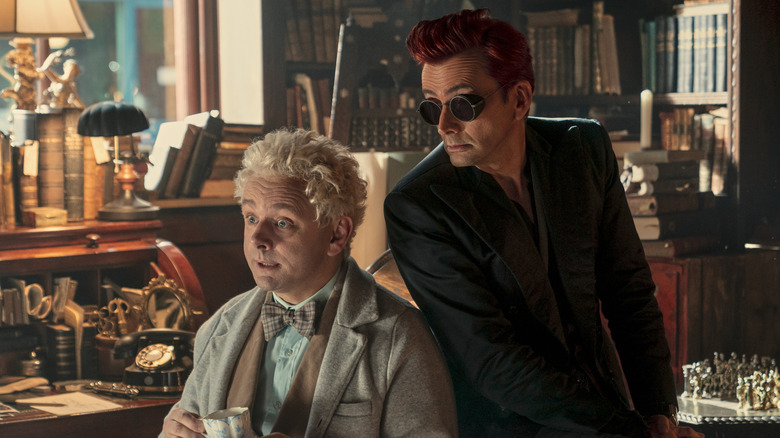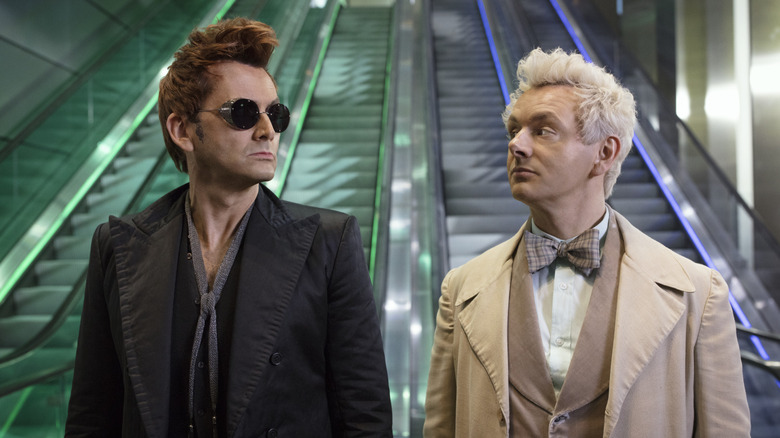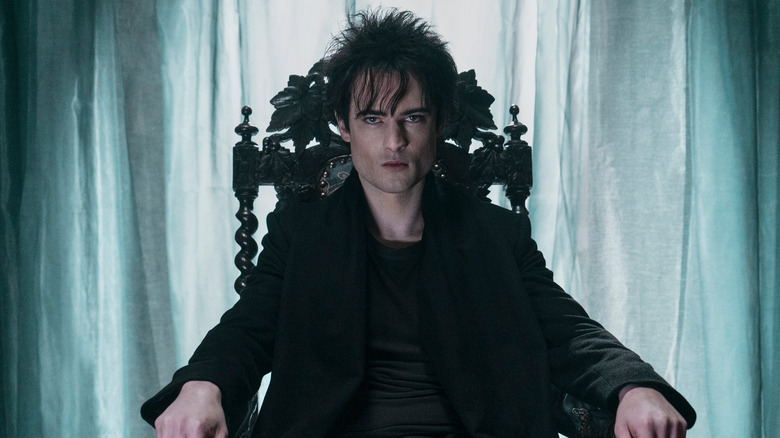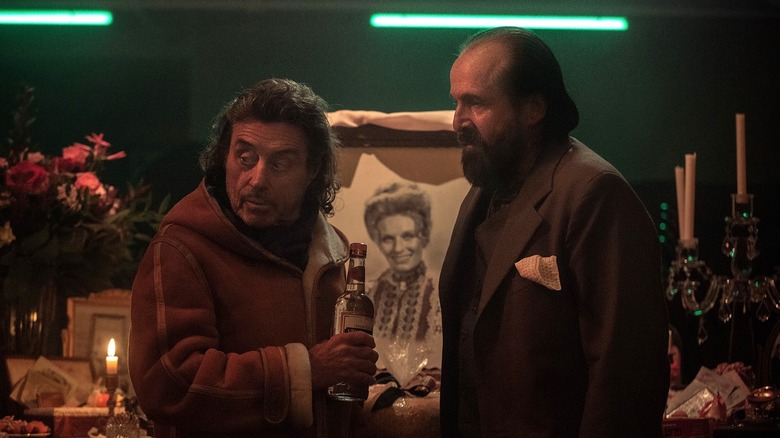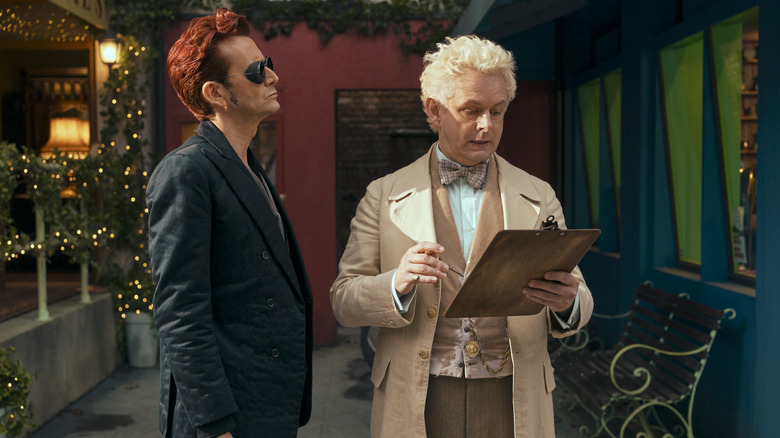Between Good Omens 2 & Sandman, Hollywood Has Finally Figured Out Neil Gaiman
Neil Gaiman is a writer who needs no introduction. Over his storied career, the Hampshire-born writer has been one of the most celebrated writers of his generation. His comics and books — like "American Gods" and "The Sandman" — redefined the fantasy genre and have remained in print decades after their initial publications.
But, as is the case with any successful author, Hollywood eventually came calling. In the 1990s, Gaiman began optioning his books to the screen and soon learned how studios would seek to radically alter his work. As he told Empire in 2022 (via SYFY), "I've been around the block in Hollywood enough times to know it is very common for people to go, 'Hey, we love your pizza. The only thing wrong with it is that it is round and flat and covered in cheese and tomato sauce. Can you change these things?'"
Although Gaiman's "pizza" was altered many times, most notably with Starz's overburdened "American Gods," he proved that the original recipe was best with Prime Video's "Good Omens." Subsequently, his successful work on that series paved the way for him to maintain the creative control he always wanted for Netflix's "The Sandman" adaptation. He now returns with Season 2 of "Good Omens," which in its quirky, digressive structure feels fresher than many major TV shows. Season 2 cements the truth that Hollywood wins when they let Neil Gaiman be Neil Gaiman.
Gaiman's flops outnumber his successes
For a while, Gaiman's legacy was seemingly doomed to remain on paper — not counting 2009's "Coraline." While "Coraline" is a genuinely titanic accomplishment in stop-motion art, it is also one of the easiest Gaiman stories to adapt and far less intricate than most of his wondrous work.
Many of Gaiman's adaptations fared worse fates. The "American Gods" book is a thick tome, following Shadow Moon as he teams up with Mr. Wednesday—later revealed to be the Norse god, Odin—to defend the old gods against modern forces. The book is written like a dharma bum novel, with Shadow's road trip across the United States exposing him to various gods and cultures. But in the adaptation, the TV show chose a more linear narrative, adding B and C plots to pad things out. Things quickly fell apart — a change in showrunners and casting drama left the show in shambles. The best parts of the series occurred when it left the main plot behind to depict the novel's iconic moments.
Although Starz's "American Gods" was messy, few Gaiman adaptations have aged well. "Lucifer," which loosely adapted the Devil character from "The Sandman," lasted a few seasons on Fox before being canceled — although Netflix revived it and the show cultivated a strong fan base. "Stardust" was a forgettable fantasy flick. Let's not talk about A24's adaptation of Gaiman's short story, "How to Talk to Girls at Parties," at all, please!
Good Omens changed Gaiman adaptations for the better
"Good Omens" is one of Gaiman's most beloved novels — a satire he co-wrote with the late Terry Pratchett of "Discworld" fame. Gaiman is Jewish, but he was raised in multiple religious practices. "Good Omens" lightheartedly questions Christian theology, specifically Heaven and Hell. The story revolves around an angel and a demon who become friends and avert the apocalypse.
Fans were cautiously delighted when Prime Video announced its miniseries adaptation of "Good Omens." Their optimism increased when "Doctor Who" star David Tenant was cast as the demon Crowley alongside Michael Sheen ("Masters of Sex") as the angel Aziraphale. Then Jon Ham, Benedict Cumberbatch, and Frances McDormand came aboard, guaranteeing the show would dazzle.
In 2019, the first season aired — faithfully adapting the book's events. Unlike his other adaptations, this one kept its sly whimsy intact. By now, Gaiman had learned to keep a controlling hand on his adaptations: He remained the head writer and executive producer. Ultimately, the series became popular, garnered nominations for three Emmy Awards, and won a Hugo and Bradbury Award. With "Good Omens," Gaiman finally began to crack the code of adapting his work to the small screen, and he followed its success with the most long-awaited adaptation of his career.
The Sandman is a triumph among Gaiman's adaptations
When looking at Gaiman's prolific body of work, none feels more impactful than "The Sandman." His comic chronicled the ethereal adventures of Dream of The Endless. Due to its esotericism, non-linear plots, and phantasmal settings, the series was considered impossible to adapt. How do you adapt a scene where Dream challenges Lucifer to a cosmic battle of imagination?
Versions of "The Sandman" adaptation languished for decades in development hell. Gaiman heard pitches from multiple major studios and even attempted a film adaptation with Warner Bros. that would have starred Joseph Gordon-Levitt. But in 2019, nearly 30 years after he began shopping it around, Gaiman signed a deal with Netflix. "The Sandman" hit the streamer in August 2022, starring Tom Sturridge as Dream. Almost immediately the show was embraced by fans for its dreamy adaptation.
What made the Netflix production successful was that it refused to shoehorn the source material into a traditionally linear TV plot. The "Sandman" books are a series of digressions from the present tense. The Netflix adaptation keeps those tangents intact: Dream visits a convention of serial killers, meets up every hundred years with a man granted immortality, and even has that battle of the minds with Lucifer (Gwendoline Christie).
However, its unique storytelling meant "The Sandman" Season 1 had a lackluster finale in comparison to where the series will go. Still, it was delightful moment-to-moment and rocketed to the top of Netflix's ranking. Of course, Gaiman would go on to repeat his success with Season 2 of "Good Omens."
The failure of American Gods led Neil Gaiman to his renaissance
Like every interesting writer, Gaiman's work is full of rough edges — many of which have been sanded down to make them palatable for mass consumption on-screen. But now Gaiman has entered a new era of producing television work that maintains his strange and psychedelic signature formula.
Gaiman isn't shy to discuss his battles with the entertainment industry. He has pulled out of a project when studio interference threatened to stray too far from his vision. "Stardust" was wrangled through several iterations, with Gaiman telling MTV in 2007, "I don't want to live in a world where every review of 'Stardust' says, 'This is a really bad film made from a really wonderfully illustrated novel.'" Similarly, the author waited 30 years to adapt his most beloved work, "The Sandman," in a way that satisfied him.
Nothing illustrates the frustrating lack of control Gaiman once had over his adaptations like "American Gods." Original showrunner Bryan Fuller ("Hannibal") left the project, and fan-favorite actor Orlando Jones, who played Mr. Nancy, was fired before Season 3 over creative differences. Gaiman says that experience led him to take creative control over "The Sandman." "I'd been frustrated with American Gods, where my notes on scripts would be ignored," he told Empire (via SYFY). "But finally, I was in control, and finally, we were at a point where I had the power to bring into existence the kind of Sandman I would like to see on screen."
Good Omens Season 2 is the Gaiman formula perfected
"Good Omens 2" is much more like Netflix's "The Sandman." Gaiman, who wrote the majority of Season 2, structured the episodes in a similar manner to those of "The Sandman" — allowing flashback episodes to take place at various periods. While there is an overarching narrative involving the angel Gabriel (Jon Hamm) arriving on Earth and becoming a walking MacGuffin for the forces of Heaven and Hell, each episode feels more interested in unpacking the history of Crowley and Aziraphale's relationship. One episode centers on their respective involvements in the biblical story of Job, while another focuses on an early 19th-century morality tale involving grave robbers and early modern medicine. Through these digressions, Gaiman explicates the nature of his main characters' eternal bond and examines potent moments of morality, justice, and self-determination.
The result? "Good Omens 2" is an appealingly unique and consistently engrossing season of television. Stamped with Gaiman's sensibilities, "Good Omens 2" applies its digressional structure of storytelling to a whimsical world. We might conceive of this structure as a chain of Christmas lights: Each bulb represents a self-contained flashback story, but they're all chained along the wire of the present-time plot. The wire isn't the most important bit, but it holds, organizes, and makes sense out of the bright light's shape. Watching "Good Omens 2," one wonders why Hollywood ever dared to interfere with Gaiman's creative process. Thankfully, it also proves they've learned to stop second-guessing him.
